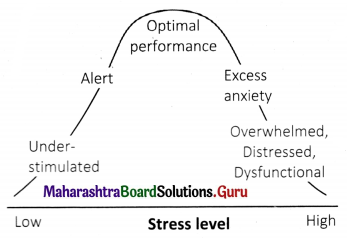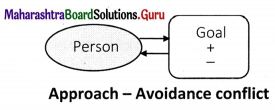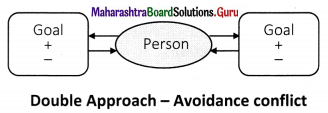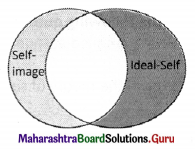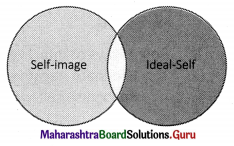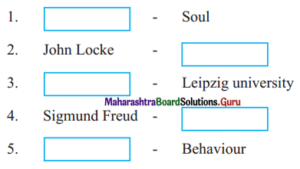Psychology Class 11 Chapter 8 Memory Question Answers Maharashtra Board
Balbharti Maharashtra State Board Class 11 Psychology Solutions Chapter 8 Memory Textbook Exercise Questions and Answers.
Memory Class 11 Psychology Chapter 8 Questions and Answers
1A. Complete the following statements.
Question 1.
One of the important processes for storage of information in the LTM is _____________
a. perception
b. elaborative rehearsal
c. encoding
Answer:
b. elaborative rehearsal
Question 2.
Memory is a/an _____________
a. activity
b. process
c. performance
Answer:
b. process
![]()
Question 3.
_____________ memory has the shortest duration.
a. Sensory
b. Short Term
c. Long Term
Answer:
c. Long Term
Question 4.
_____________ memory is also known as Working Memory.
a. Long Term
b. Accidental
c. Short Term
Answer:
c. Short Term
Question 5.
_____________ memory has unlimited capacity.
a. Sensory
b. Short Term
c. Long Term
Answer:
a. Sensory
Question 6.
The span of Short-Term Memory is _____________
a. 5+/-2
b. 7+/-2
c. 9+/-2
Answer:
b. 7+/-2
1B. State whether the following statements are true or false. If false, correct them. If true, explain why.
Question 1.
Our sense organs also have memory.
Answer:
True
Explanation: Our sense organs have the capacity to retain the sensory impression received through the five senses for a very short time even after the source stimulus is withdrawn. It is known as sensory memory.
![]()
Question 2.
Short-term memory has an unlimited capacity.
Answer:
False
Reason: STM holds the information between 15 to 30 seconds and the capacity of STM is about seven items at a time. Fleece, has limited capacity.
Question 3.
Conscious memory of facts and events is called explicit memory.
Answer:
True
Explanation: Explicit memory is a type of LTM that contains conscious memories of facts and events.
Question 4.
Implicit memory is the memory of skills.
Answer:
True
Explanation: Implicit memory is the unconscious memory of skills and how we do things, regarding the use of objects or movements of the body.
Question 5.
When we memorize meanings, concepts, and principles, it is called episodic memory.
Answer:
False
Reason: Episodic memory is a memory of experiences and specific events which we recall step by step to reconstruct actual events.
Question 6.
The method of relearning is also known as the saving method.
Answer:
True
Explanation: In relearning method, there is a saving of time taken to learn the same material. Fleece, this method is also known as the saving method.
![]()
Question 7.
The most vivid memory is flashbulb memory.
Answer:
True
Explanation: Flashbulb memories are vivid memories of what we were doing at the time of an emotion-provoking event.
1C. Identify the odd item from the following.
Question 1.
Encoding, Storage, Tip of the tongue (TOT), Retrieval
Answer:
Tip of the tongue (TOT)
Question 2.
Keyword method, Method of Loci, Chunking, Rote learning, First letter technique
Answer:
Rote learning
Question 3.
Sensory register, STM, Flashbulb memory, LTM
Answer:
Sensory register
Question 4.
Recall, Recognition, Relearning, Trace decay
Answer:
Trace decay
1D. Match the following pairs.
Question 1.
| A | B |
| 1. A technique to improve memory | a. Short-term memory |
| 2. The most vivid memory | b. Declarative memory |
| 3. Working memory | c. Implicit memory |
| 4. Most organized memory | d. Flashbulb memory |
| 5. Playing the harmonium after a long time | e. Method of Loci |
| 6. Writing an essay on perceptual process | f. LTM |
| g. Recall method | |
| h. Relearning method |
Answer:
| A | B |
| 1. A technique to improve memory | e. Method of Loci |
| 2. The most vivid memory | d. Flashbulb memory |
| 3. Working memory | a. Short-term memory |
| 4. Most organized memory | f. LTM |
| 5. Playing the harmonium after a long time | c. Implicit memory |
| 6. Writing an essay on perceptual process | g. Recall method |
2. Answer the following questions in around 35-40 words each.
Question 1.
Explain any one example of Flashbulb memory from your life.
Answer:
- I clearly remember the day when my grandmother passed away.
- On that day, I had an omelet for breakfast and went to college around 10.30 a.m. I attended only two lectures and then received a call about this bad news. After that, my best friend accompanied me home.
![]()
Question 2.
Explain the model of working memory proposed by Baddeley.
Answer:
- Baddeley called STM a working bench of memory.
- In the working memory model given by him, a central executive is responsible for the coordination between sub-systems of the phonological loop, episodic buffer, and the visuospatial sketchpad.
- Both phonological loop and visuospatial sketchpad have two components.
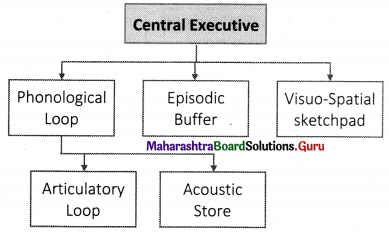
Question 3.
Explain the Tip of the tongue (TOT) phenomenon with an example.
Answer:
- Sometimes, when we search through our library of experiences to retrieve information from LTM, we cannot recall it even when we have that information on the tip of the tongue.
- e.g. you want to recall the name of your cousin’s favourite clothing brand. Instead of that name, you recall all similar names.
Question 4.
Give an example of episodic memory.
Answer:
- I remember a four-day-long celebration of my sister’s wedding.
- It started with Haldi followed by Mehendi and the sangeet ceremony. After that, there was a grand wedding followed by a reception ceremony.
- I also remember all preparations, outfits that I wore, and the food that we had in those four days.
Question 5.
What is motivated forgetting?
Answer:
- Motivated forgetting is a behaviour in which people may forget unwanted memories either consciously or unconsciously.
- It is also called a conscious coping strategy but it should not be confused with defense mechanisms.
- There are two levels of motivated forgetting, viz. Repression and Thought suppression.
3. Compare and contrast.
Question 1.
STM and LTM
Answer:
- Only the significant sensory inputs enter the Short-Term Memory (STM) through maintenance rehearsal. On the other hand, some items in STM enter the Long-Term Memory (LTM) after elaborative rehearsal which makes information meaningful and connects the same with already existing information in the LTM.
- STM holds the information between 15 to 30 seconds and the capacity of STM is about seven items at a time. Conversely, once information enters LTM, it is retained more or less permanently and the amount of information stored in LTM is unlimited.
![]()
Question 2.
Implicit Memory and Explicit Memory
Answer:
- Implicit memory is the unconscious memory of skills and how we do things while explicit memory is conscious memory of facts and events.
- Implicit memory is also known as procedural memory while explicit memory is also known as declarative memory.
Question 3.
Semantic memory and Episodic memory
Answer:
- Semantic memory is a more structured record of facts, meanings, concepts, and knowledge. On the other hand, episodic memory is a memory of experiences and specific events which we recall step by step to reconstruct the actual events.
- Semantic memories have personal context which includes vocabulary, mathematics, rules of logic while episodic memory is the memory of autobiographical events with times, places, and associated emotions.
Question 4.
Storage failure and Retrieval failure
Answer:
- In case of storage, failure acquired and encoded information is not stored properly while in case of retrieval failure, problems arise while recalling the stored information for its actual use.
- Both storage failure and retrieval failure make it difficult to use the retained information in the future.
Question 5.
Recall method and Recognition method
Answer:
- The recall method involves remembering a fact, event, or object that is not currently physically present and requires the direct uncovering of information from memory, (e.g. long essay-type answers). In the recognition method, already learned material is present and the learner has to recognize it. (e.g. MCQs).
- Recognition is relatively easier than recall. So, a score of memory by recognition method is usually more than the recall method.
4. What will you do if…
Question 1.
You have to prepare a long speech covering all the activities in your college and present at the annual function
Answer:
- I will make a list of all the activities and rehearse it a number of times so as to ensure better retention.
- I may also make a note with all points in brief which I can refer to if I forget something in the middle of a speech.
![]()
Question 2.
How will you apply ‘POWER’ to prepare for the final exam of Psychology?
Answer:
- Prepare: Before starting to study, I would prepare myself for it by setting goals. I will make myself aware of why am I studying Psychology, e.g. for acquiring good marks in the final exam.
- Organize: I will organize the study material properly and make a schedule for each chapter. I will allot less time for chapters that are easy and familiar. I may study these chapters when I am a bit tired. Conversely, I will allot more hours to chapters that are unfamiliar, complicated, or technical. I will also ensure to study these complex chapters when I am fresh.
- Work: I know that I have to work hard to achieve the goal of acquiring good marks. So, I will learn with the motive to understand and remember. I will try to associate new information with something that I have already learned.
- Evaluate: I will try to evaluate my progress by solving practice papers. It will enable me to know how much I have learned and the quality of my knowledge.
- Rethink: I will reanalyze, review, question, and challenge myself. I will also rethink whether I need to change my method of studying so as to achieve the goal of acquiring good marks in the final exam.
5. Short Notes.
Question 1.
Characteristics of Memory
Answer:
- Memory is an ability by which information is encoded, stored, and retrieved when needed.
- Three basic processes or characteristics of memory are Acquisition, Storage, and Retrieval.
- The acquisition is the process of acquiring information from our sense organs. The information acquired and encoded is stored over a period of time. In retrieval, the stored information is recalled for the purpose of its actual use.
- There are three stages of memory, viz. Sensory information store, short-term memory, and long-term memory.
Question 2.
Techniques to improve memory
Answer:
Some techniques to improve memory are as follows:
- Keyword method: In the keyword method, any two different pieces of information can be linked together. It is an effective method for remembering definitions and learning foreign language vocabulary.
- Encoding specificity: According to encoding specificity, memory is improved when information is available while learning is also available at the time to recall.
- Method of loci: It involves creating an imaginary route so that things can be remembered in a better way. e.g. steps to solve mathematical problems.
- Mnemonic devices: Mnemonics will include acronyms or first letter techniques (e.g. VIBGYOR includes colours of the rainbow). It will also include visualization. Another technique is chunking where one can place large information into small chunks.
- Practice and rehearsal: Relearning the same material a number of times lead to better retention and better recall. For small size or easy material, it is effective to optimally utilize our time and learn the entire material. For large size or difficult material, we must take breaks and learn the material in parts.
- Minimizing interference: We should not learn similar subjects together as they might interfere with each other. Also, one must take a rest for minimising such interference.
- POWER method: One can also use the POWER method for improving memory. Here, P stands for Preparation, 0 stands for Organisation, W stands for Work, E stands for Evaluation and R stands for Rethinking.
![]()
Question 3.
Motivated forgetting
Answer:
- Motivated forgetting is a behaviour in which people may forget unwanted memories either consciously or unconsciously.
- It is also called a conscious coping strategy but it should not be confused with defense mechanisms.
- There are two levels of motivated forgetting, viz. Repression and Thought suppression.
- Repression: Sigmund Freud’s Psychoanalytic model states that we subconsciously push unwanted thoughts and memories into our unconsciousness. People think that such repressed memories are completely forgotten.
- e.g. a girl who had experienced sexual abuse during childhood may completely forget about it. But she may have difficulty while forming a romantic relationship.
- Thought suppression: It is a conscious effort where we forget the memories of unwanted incidents and experiences of our lives, e.g. a person will avoid talking about his breakup.
- Thought suppression can be time-consuming and also quite difficult as such suppressed thoughts tend to reoccur, e.g. a person may try to suppress the thoughts about his ex but he may not be successful in doing so.
Question 4.
Causes of forgetting
Answer:
- Trace decay: Our memories fade out when we don’t use them for a longer period, i.e., traces of memory get decayed over time if they are not used.
- Trace distortion: Some researchers believe that memory traces are not decayed but are distorted over a period of time and forgetting occurs.
- Interference: Some researchers believe that we forget when materials that we learn one after the other interfere with each other. There are two types of interference, viz. retroactive interference and proactive interference.
- Motivated forgetting: It is a behaviour in which people may forget unwanted memories either consciously or unconsciously. There are two levels of motivated forgetting, viz. Repression and Thought suppression.
6. Answer the following questions in 150-200 words.
Question 1.
Explain the process of human memory in detail.
Answer:
- Memory is an ability by which information is encoded, stored, and retrieved when needed.
- The basic processes of memory include acquisition (encoding), storage, and retrieval.

- Acquisition/Encoding: Acquisition is the process of acquiring information from sense organs. Encoding is the process of transforming the information received into suitable symbols like pictures, figures, words, numbers.
- Storage: The information acquired and encoded is preserved over a period of time. The process of storage is essential for using that information in the future.
- Retrieval: It is the process of recalling the stored information for the purpose of its actual use. We tend to retrieve mobile numbers, names, etc. in our daily life.
- We can think of these processes as analogous to the functions of a computer.
![]()
Question 2.
Explain the theories of forgetting in detail.
Answer:
- Forgetting is the failure to retrieve the material from our long-term memory which we had already stored.
- Researchers have put forward various theories of forgetting. Each theory highlights different reasons behind forgetting.
- The various theories of forgetting are: Trace decay theory, Trace distortion theory, and Interference theory.
- Trace decay: Our memories fade out when we don’t use them for a longer period, i.e., traces of memory get decayed over time if they are not used.
- Trace distortion: Some researchers believe that memory traces are not decayed but are distorted over a period of time and forgetting occurs.
- Interference: Some researchers believe that we forget when materials that we learn one after the other interfere with each other. There are two types of interference, viz. retroactive interference and proactive interference.
7. Arrange the following elements in concepts of memory in ascending order.
Question 1.
Elaborative rehearsal, Short Term Memory, Receiving information from the environment, Long Term Memory, Retrieval
Answer:
- Receiving information from the environment
- Short Term Memory
- Elaborative rehearsal
- Long Term Memory
- Retrieval
Activities
Activity 1 (Textbook Page No. 87)
Do you remember your first picnic at your school? Do you remember your primary school teacher? Now can you remember what food you ate last Monday? Why you can remember some incidents from the past clearly while you cannot remember some things which happened yesterday?
Answer:
We remember some incidents from the past clearly when they are a part of our long-term memory. Similarly, we cannot remember certain incidents from the recent past whey they form a part of our sensory or short-term memory.
![]()
Activity 2 (Textbook Page No. 87)
Why does this happen? 25 workers used to work in Thomas Edison’s Bulb and Phonogram unit of industries. There was a huge tree near his company. After 6 months, Edison asked his workers about the huge tree but not a single worker could give information about that tree. Why do you think this happened despite seeing the tree every day?
Answer:
I feel the none of the workers could give information about the tree near their company since it was a part of their sensory memory, i.e., they perceived the stimulus (tree) with sense organs but did not rehearse it enough for it to become a part of their long term memory.
Class 11 Psychology Textbook Solutions Digest
